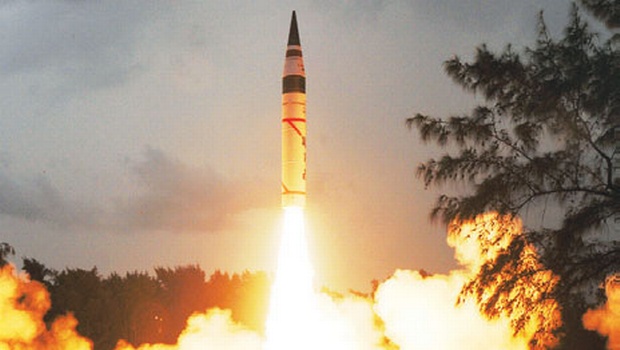Agni-V: India’s New Deterrent
04 May, 2020
The nation awaits with bated breath the launch of India’s Agni-V missile that would understandably cause concern in some parts of the world more specifically in the neighbourhood.

The Agni-V is a 50-tonne, 17.5-metre tall, three stage solid-fuel ballistic missile with a range of around 5000 km. It has been developed by the Indian Defence Research and Development Organisation at a cost of over Rs 2,500 crore. The operational version of the Agni-V will be canister-launched and vehicle mounted for making it highly road mobile. With these attributes, it would have the capability to of rapid deployment in any part of the country. Its navigation system will be enhanced considerably with the commissioning of the Russian GLONASS GPS system for which India has entered into an agreement with Russia.
The Agni-V will be capable of carrying a nuclear warhead. This capability in due course, will be upgraded to carry Multiple Independently Targetable Re-entry Vehicles (MIRV). This payload will be able to deliver up to ten nuclear warheads in a single launch assigned to different widely separated targets. Alternatively, two or more warheads can be assigned to a single target. The MIRV payload capability is a feature currently under development. There is also the potential to develop a submarine-launched version should the situation so demand in the future. The Agni-V system is being developed to provide a credible second strike capability.
The Agni-V is generally being regarded as China-centric. It undoubtedly has the range to deliver nuclear strike against targets in most parts of China if launched from the North Eastern parts of the country. However, in order that the whole of China with its enormous strategic depth is brought within strike range of missiles launched from any part of India, there would be a requirement to develop a system with twice the range of the Agni-V. China already has a massive nuclear arsenal with the 11,200 km Dong Feng-31A capable of hitting any part of India even when launched from deep inside the country.
Apart from the Dong Feng-31A, China has already deployed long and medium range missiles in Tibet and Xinjiang provinces specifically to strike Indian cities and other high value establishments. Compared to China, India is clearly far behind in the missile race. However, given India’s self restraining “no first use” policy, the Agni-V is meant only to be a credible deterrent.
Courtesy: Opera News/ indiandefencereview.com

